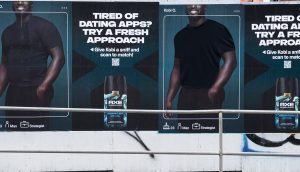Every week MiC invites Canada’s media gurus to survey the mediascape and share the things they find most interesting and noteworthy. Today Ken Wong, VP of knowledge development at brand strategy and marketing consulting firm Level 5 and faculty prof at Queen’s Business School, puts forward his picks: campaigns he says have a whole new perspective when looked at from the point of view of a CEO, rather than of a marketer.
We spend our time to talking to CEOs about marketing issues. One of the things we’re hearing is that they don’t look at marketing the way marketers do. While we’re being creative, authentic and every other way of saying ‘fresh’ and ‘imaginative,’ CEOs have a much more basic view of things: will it build revenue? Create competitive advantage? Reduce costs? No wonder we hear marketers complaining that some CEOs just don’t get it.
Or is the problem that marketers don’t get it? Here are three examples of campaigns of varying novelty in their media and message. We chose them because, to different degrees, everything they did – from message crafting to media selection – was tied together. These folks weren’t trying to be on the edge in their media selection: they were trying to use the right media for what they needed to do.
One of the best executions for its brilliance and simplicity was Kellogg’s Special K ‘Take the Challenge’ campaign, the goal of which was to reinvigorate the brand position that now included the introduction of product line extensions by driving both transaction and engagement amongst its target audience: women.
Operating from a digital core, all media drove prospects to search for Special K on Yahoo, which then drove them to Specialk.com, where users could get health-related information, get advice from third-party experts and ultimately take the Special K Challenge and share their experiences via their social media group.

The results: search traffic jumped almost 800% through (and after) the campaign, and exceeded pre-campaign levels for five months. Tens of thousands of women participated in the challenge, sharing their experiences, learning from others and becoming brand advocates in the process. Sometimes simple is the most effective.
Scotiabank’s Line of Credit Adventures Contest at Fundyourfuture.ca looks like, at least on paper, a CEO’s dream. It reaches out to a key long-term market with something beyond basic credit and savings services. It makes the offer at a time of year when finances are clearly top-of-mind, and it builds upon the existing, more pleasure-related Scene card to build a broad base of appeal. It features relevant information on credit and money management and ties it to a contest with a prize related to the consumption problem. It delivers this information in both text and in video format (to a video generation) and incorporates elements of social networking as part of a broader digital strategy. It covers all the bases and should result in both revenue growth and competitive advantage.

However, sometimes the media can confuse the message, and that may be the case here. The video is decidedly cheesy and intentionally unprofessional in production values. I’m sure there was a ton of research that said young people see financial institutions as impersonal and distant to support these choices. Unfortunately, my students responded to this execution with ‘would I trust these folks with my money?’ There is a middle ground between stodgy and funky, and while the media chosen were right, the message got lost.
In contrast, TSN’s ongoing celebration of its 25th year lacks glam and extensive use of new media. And it works. It works because someone at TSN decided in favour of the rarefied air of going beyond brand status to becoming part of the fabric of Canadian life. This isn’t a show or even set of shows: it’s a portal for gaining memories. And this campaign reminds us that TSN provides that portal through its original programming, its sometimes quirky sportscasters and special moments in Canadian sports. Add to this its partnership with Kraft in sponsoring the ‘Celebration Tour’ that focuses on sport at the community level, and the campaign sets the stage for future memories.

Best of all, it does it without making you feel like you’re a target audience and the message doesn’t feel like a sales pitch. It’s basic, real, old-school and loaded with ‘product demonstration’: exactly the kind of thing you’d want as part of being Canadian, As for TSN, in a world hyped on new media, it focused instead on a positioning it can own.























